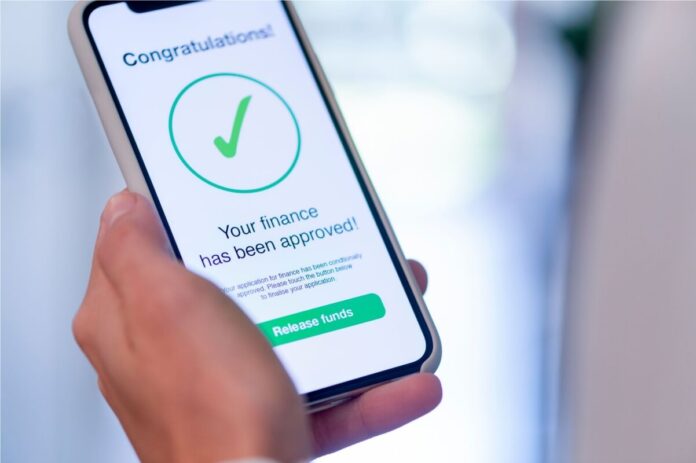The entry of a two nano lending companies has left the financial services industry baffled. The question on everyone’s mind is how on Earth did these two nano lending companies accumulate more users than the decades-old mobile money wallets? These new nano lending companies have also managed to disburse more loans to retail customers than some of the established microfinance companies.
For the sake of this story, we are focusing on just two nano lending companies, while in reality you might have heard about the several others out there. The reason why we’re focusing on these two is because they are the only nano lending companies that are licensed by the SECP to legally carry out digital nano lending business.
One of them is Seedcred Financial Services which runs the digital lending app Barwaqt, and the other is Sarmaya Microfinance Private Limited, which runs apps EasyLoan and PkLoan.
By far, the biggest in the business is Barwaqt whose management claims they have approximately 10 million downloads of the app. Seedcred, the patron of Barwaqt, is owned by Fintech OPay Pakistan which is part of the Nigerian Fintech OPay valued at $2 billion. OPay is backed by some global VC giants such as SoftBank and Sequoia Capital. The fintech company raised $400 million in funding in August last year.
Barwaqt’s scale matters because 10 million downloads were achieved in a year. The management of the company further claimed in conversations with Profit that they have serviced 2 million borrowers and PKR 16 billion worth of loans disbursed. Compared to the number of downloads and the short time span of a year, this is significant.
The SECP, however, has different numbers. According to them, the total borrowers financed by eight NBFC were 551,000 until March 2022, with PKR 11 billion disbursed by all of these entities combined.
When the discrepancy was brought to Barwaqt, they stood by their claim which means Barwaqt could have more borrowers and disbursed more loans than the entire industry it operates in. To add to the confusion, an article published in Dawn in July, 2022 carried a third set of numbers, claiming Barwaqt has 8 million “clients” with PKR 4 billion disbursed.
It seems reliable numbers on what exactly is going on within the nano lending space are difficult to come by.
How are these numbers impressive? Well, established fintech companies JazzCash and EasyPaisa both have 10 million plus downloads each.
They, however, managed to accumulate these downloads over decades of existence in Pakistan’s financial sector. And according to the Mobilink Microfinance Bank’s (the bank behind JazzCash) financials available publicly, its total loan disbursement grossed up to PKR 10-12 billion in 2021.
According to a senior official at EasyPaisa, the growth of nano lending apps such as Barwaqt is an eye opener to the potential of nano lending. Had they known this earlier on, “EasyPaisa would have structured their nano lending product differently.”
So what’s making this growth possible?
Briefly put, there is a lot of scope for lending in Pakistan because commercial banks have largely shunned this market. For commercial banks, it does not simply make a business case to serve customers seeking such nano loans, which range from Rs1,000 to 50,000.
According to Abrar Ameen, the CEO of SeedCred Financial Services, their average loan size is PKR 7,000.
For commercial banks, the cost of serving these customers is high and such consumers are also very risky to lend to since most of them do not have a solid credit history to assess credit worthiness. In case of microfinance banks too, the cost of serving these customers is high and hence the interest rates are very high and getting approved for loans is a cumbersome process with a lot of paperwork involved.
Consequently, access to credit for Pakistanis according to the World Bank has hovered at around 13% only of the total population.
The opportunity, alone, however, does not fully address the growth trend of nano lending apps. This is where the mention of questionable practices of nano lenders get a mention: while they have been able to grow, these apps haven’t been following fair business practices such as transparent disclosure of terms and conditions to customers and aggressive and unique loan recovery tactics which can be called unethical.
This has been helped by a regulator, the Securities and Exchange Commission of Pakistan (SECP), which regulates companies broadly but does not regulate finance companies particularly. It was only after a deluge of complaints on social media that the SECP began to look into the malpractices of nano lenders and ordered corrective actions.
Anatomy of a loan shark
Picking up from social media, people have simply been mad. The nano lending apps have been under a barrage of criticism for some time now for being loan sharks – a term first used during the American Civil War and is characterised by lending on exorbitant interest rates and violent collection practices.
It had been characterised as such because loan sharking involved lending of illicit money and was a feature of criminal enterprises, and therefore, operated outside the ambit of state laws.
Since no legal contracts could be enforced, lending such money used to be very high risk and carried very high interest rates. Collection practices for such loans included resorting to violent tactics to make recoveries as formal law enforcement channels could not be involved in collection of such loans.
In fact in Pakistan, setting up microfinance banks was to keep people from being exploited by loan sharks operating informally, using illicit money to lend out loans and then recovering them through the threat of violence.
In Profit’s own interaction with an actual loan shark, the latter would not even disclose his name on the phone. The loan shark was cautious about speaking to the publication, reinforcing our notion that he was operating outside legal channels.
This context is important when discussing the new age nano lending apps. One set of these apps operates within the regulatory framework, that is they are licensed by the SECP to do such business legally.
The other set of apps operates outside the regulatory framework, are not licensed by the SECP and are hence, illegal.
According to the list shared with Profit by SECP, companies that are licensed to do such lending are SeedCred Financial Services (Barwaqt) and Sarmaya Microfinance (EasyLoan and PkLoan).
The list of apps that are not registered by the SECP but are still involved in nano lending business illegally is a long one. The SECP shared names of 13 illegal apps that were not authorised to carry out lending business, with an additional four apps identified by Profit.
These apps include Flexi Money, Zephla, EasyMoney, Qarza Loan, WeCash, Rapid Credit, AiCash, EasyCash Loans, Fori Qarz, Fori Money, Fair Loans, Plati Loans, Olive Cash, Superb Loans, UrCash and MyCash.
Among these 17, only two are no longer on Playstore. Collectively, these apps have downloads amounting to over 2.2 million.
The dichotomy of these apps is important because one set of these apps is completely illegal, which is how loan sharks operate. The other set of apps has some features of loan sharks but are not illegal. In fact, by operating as licensed entities, the regulator seeks to keep predatory practices in check.
These apps, however, have arguments that they are not predatory in the first place because of how this financing works.
While the SECP has taken some soft action against the registered entities to keep their supposedly predatory ambitions in check, it is the actual loan sharks, the unregistered apps, against which disgruntled consumers cannot enforce any legal action which are operating unabatedly.
How are these apps predatory?
The set of customers that gets enticed to apply for these nano loans are possibly the poorest segments of society, with irregular pays and no savings: in short desperate. They could be taking out a loan for an emergency for which they would have no savings to spend.
It is the people that are desperate for money that are prone to exploitation by loan shark lenders. It is exactly to stop this exploitation that the financial sector is heavily regulated.
There has been hue and cry of unfair terms and exploitation by these lenders as far as the markup rates and fees charged by them goes. They are also seen to have been violating best business practices such as transparency and ethical recoveries.
The experience of one of the borrowers from the EasyLoan app was narrated to us with statements. The borrower took a loan of Rs16,800 from the app on May 17, 2022, and made five payments of Rs4,200 each between May 17 and June 16, paying Rs21,000 in total as per the terms of the loan repayment. That’s 25% interest in over a month.
What followed later was unexpected. Agent from EasyLoan’s loan recovery cell said that the Rs4,200 payment that was made five times had not really gone towards the repayment of loan amount but towards some extension charges. And that the loan amount was still pending. Mind you that the borrower in question had to ask someone who was well educated to figure out what was going on and sort out the matter. Borrowers often don’t really understand these loans before they take them perhaps because of overall illiteracy.
Bear also in mind that sometimes low income workers take out such loans and then reach out to people they work for, misrepresent that they are being exploited and ask for financial help from them.
In a recent example that this reporter witnessed, a blue collar worker misrepresented that he was getting recovery calls from FINCA Microfinance Bank because he had missed a payment and needed financial help in repayment of his loan.
When the bank was contacted, the borrower in question had successfully completed his loan repayments and had taken another loan on which he was on time on his payments. In fact, when he was told that the bank would be called to verify the veracity of his claim, he withdrew his request for financial help.
The point here being that when in poverty, false complaining to secure financial help is real. It could be to individuals and authorities. The SECP has told Profit that some of the complaints received by them regarding nano lending apps were dismissed because these complaints were unfounded.
The SECP did not however share the number of complaints that were dismissed.
Back to our EasyLoan guy.
From the information received, the borrower’s father was called at least five times in a day for recovery of the loan of his son, when it was fully paid.
Another feature of these apps is that when applying for a loan, these apps ask for permissions to access contacts, calls logs and even pictures. The borrowers, perhaps because of their desperate circumstances and illiteracy, go ahead with giving such permissions and only realize what it means when the close ones in their circles are called for recoveries of loans.
In a conversation with Profit, one call center agent at EasyLoan responsible for recoveries, without disclosing his name, said that there is no guideline from the company pushing agents to resort to threats for recovery of loans. However, agents receive a commission for meeting recovery targets which acts as an incentive to recover loans under all circumstances.
“It is Rs500 for the day if 75% of loan recovery targets assigned to an agent are achieved. It is Rs1,000 if 90% is achieved. I am a student and many of the call centre agents are students like me. To achieve their targets, some of them get carried away and use harsh language to achieve their targets,” he said.
The case of our EasyLoan borrower was resolved by the company after some aggressive complaining and after the regulator intervened when there was a national level hue and cry about these apps acting like mobsters.
EasyLoan also took action against those call centre agents who were resorting to aggressive tactics for recovery after a meeting of licensed lenders was called and the SECP raised concerns
The nano lenders have their own version, however.
First of all, a disclaimer: Sarmaya Microfinance, the company behind EasyLoan is understood to have, according to a Dawn article, markup rates in the 20 per cent range for a month. On an annualized basis, it would be 240% for the year.
In a conversation with Profit, an official from SECP also vouched that their internal audit revealed that Sarmaya Microfinance rates were not predatory and were in the 20 per cent range.
Barwaqt on the other hand charges markup rates that are in the 40 per cent range for a month, and close to 500% on an annualised basis. Even 40% is an industry standard, with some of the microfinance banks charging similar rates.
Nanolenders is that they charge these rates for a payback period of a month, and for annualised rate to take effect the borrower would have to keep on taking loans with the payback period of a month, for the entire year for it to be considered an extremely predatory rate. The act of piling on loans for a year is itself a highly unlikely scenario.
In our conversation with Abrar Ameen, the CEO of SeedCred Financial Services, annualizing a monthly interest rate and calling it predatory is a mistake because their lending cycle is not on an annual basis.
“Our product ends in 30 days. No one is giving or taking out a loan for a year. If we were giving out a loan for a year, we would also have set our rates based on 6-month or 1-year KIBOR and some spread,” says Abrar.
“If there was KIBOR available for a week, our nano lending rates would have been according to that KIBOR rate,” he adds.
What Abrar says makes sense but nanolending apps have been under criticism for giving out incomplete disclosures as well. Charging interest rates even if they are high is not a problem as long as these rates, as well as other fees, are disclosed fairly. The SECP has since ordered these apps to give complete disclosures.
When calculating markups or percentage returns, nanolenders such as Barwaqt have to account for return on equity, costs associated with business and the risk of default. Therefore, the interest rates in their case are high.
These three elements cannot be avoided, which drives up the markup rate but is not exploitative, Abrar argues, seconding it with the argument that the markup charged by them is now almost as much as what the microfinance banks charge.
For borrowers that are not delinquent on their payment, the markup rate goes down as they take out more loans and their limits also increase. The percentage of repeat borrowers with Barwaqt is 60%, Abrar says.
On the recovery part, Abrar says that being a licensed entity they have legal channels available for recovery of loans, the costs associated with such recoveries are high compared to the size of the loans. While reading this, imagine sending police after a borrower who has borrowed a meager Rs5,000 from Barwaqt.
In such a scenario, repetitive calls are the only way to ensure recovery. Abrar does not condone aggressive and harassing behavior but says calling customers is the only way to recover such loans.
The regulator in question
We have earlier mentioned that the regulator’s inaction on its own has helped the growth of these apps. This can be seen by the fact that it took a lot of voices to speak up resulting in the regulator to take some action against the behavior of these nano lenders,
The SECP, despite all of this, tells Profit that they have their internal mechanism to monitor these lenders.
“SECP has an elaborate Supervision function to oversee the compliance of its licensed entities. This supervision comprises risk based reviews/inspections, aimed to monitor compliance by licensed entities with on-going regulatory requirements like full disclosure to the end users, maintaining defined equity thresholds, maintaining prescribed investment in licensed business, provisioning of non-performing loans etc. targeted at viability of entity and protection of investors,” SECP told Profit in an email.
Now, following the complaints on social media and complaints by app users to SECP, the commission has ordered some actions to be taken by nanolenders.
In an email to Profit, the SECP outlined the generic list of actions to be taken by these apps. The list of actions includes giving explicit disclosures related to interest rate, processing fee, loan tenure, overdue penalty charges and pop up of loan agreement, privacy policy, cooling off period and restricting access to only emergency contacts instead of full contact list.
The SECP has also asked to maintain a functional website in the name of the company as well as disclosure of the full name on all platforms wherever the name of digital lending apps are being used.
The regulator has further ordered to include the “Cancel” tab alongside the “Get Loan” tab on the application prior to disbursement of a loan. This is so customers may have the clear option to cancel their loan request at any time during the loan processing cycle.
Furthermore, they have been asked to establish robust grievance redressal mechanisms and have in place proper channels (i.e. an email address, a hotline and so on) for complete resolution of the complaints.
There are limits to SECP’s powers as well when it comes to regulating financial institutions. Just like the State Bank of Pakistan (SBP), the SECP can not dictate to these lenders what they should and what they should not charge to customers.
So if you think the markup rates are predatory, know that the SECP cannot order these lenders to cut their interest rates. This is because it would then be dictating the commercial interests of these entities – something even the SBP does not do.
Instead, it can just ask NBFC companies to follow a fair pricing policy or at best set a cap on fees or interest rates, which the SECP has not done yet.
Even if the SECP does set caps, it would still have to consider commercial interests of the lending entities and these entities do have arguments to negotiate a generous cap for the interest rates they charge.
Instead, the best way would be to let the market forces determine what the rates and fees should be, argues Abrar Ameen. These are still the early days of the digital nano lending ecosystem. As more entities get licensed, everyone would have to offer competitive rates which would bring down the rates for consumers.
The SECP also asserts that the number of complaints have been declining since the actions ordered by them, but did not disclose how many complaints were registered overall and historical numbers to back the claim of the declining trend.
The SECP said that they wouldl share these numbers with Profit. They were not received till the filing of this story.
What an SECP official also asserted on a call with Profit was that many complaints from users were not actually complaints of any wrongdoing, as mentioned above. These were just customers angry for no particular reason. In fact the official also asserted that the entire social media campaign was blowing the issue out of proportion and that the things were not that bad.
While actions have been taken against the registered lenders to tone down their supposed predatoriness, no substantial action has been taken by the SECP against the illegal apps which we earlier categorised as actual loan sharks because they operate completely outside the ambit of the law.
The SECP has only said that they can not directly take down these apps. Instead, it has sent requests to relative authorities to take them down, without specifying who these authorities were.
So far, only two of the 17 illegal apps have been taken down. This means the majority of the actual loan sharks are still operational.
If such a case persists long enough, the licensed ones would be at a disadvantage by being part of the formal regulatory system, under which orders by regulators would suppress their competitiveness. It’s hard to compete against illegal apps that are operating without any consequences.
Additional reporting by Ahtasam Ahmad


























Amazing Blog I like Your All Post!
see My info
Q Bazaar is another project in Lahore and before long will be a developed shopping center in the focal point of the city. Lahore is a major city and we have seen another improvement project in this city each approaching day.
Good blog with all necessary information for readers. But on a positive side one suggestion kindly keep bit summary as it is too detailed and user lost attention in between.
Govt must take an action against these shark applications. Totally fraud , scammer and some of gvt black sheeps are also involved with these black money holders . Barwaqt, sarmaya microfinance private ltd both are one united to scam pakistani poor naton.
Also keep short summary of post.
Very Good Post !
Citi Housing Kharian is set to convey every single present day office and administrations at reasonable prices.
remove the loan app frude Pakistan contact list and contact reference number collect
your blog has an ad of easyloan 😀
I have perused every one of your posts and all are exceptionally enlightening. Gratitude for sharing and keep it up like this.
사설 카지노
j9korea.com